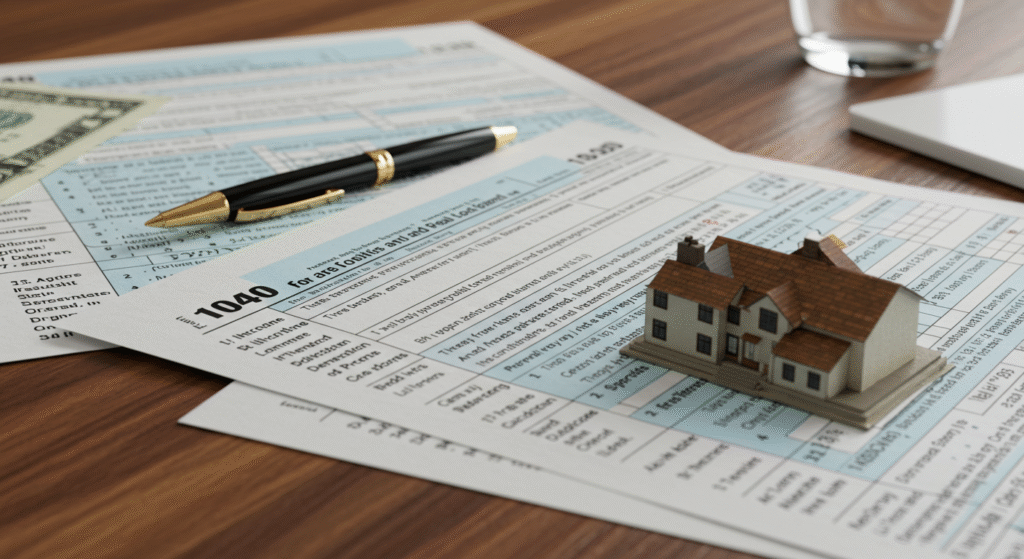Capital gains tax hits anyone selling an asset like stocks or real estate at a profit. If you’ve ever wondered why the money you make from selling your investments doesn’t all end up in your pocket, this tax is the main reason. It’s simple: when you sell an asset for more than you paid for it, that profit may be taxed.
Knowing how capital gains tax works matters because it affects how much you actually keep after a sale. Stocks and real estate have their own rules and rates, which can make things confusing if you’re not prepared. Understanding these basics helps you manage your investments better and avoid unexpected bills when the time comes to sell. In this article, I’ll break down capital gains tax clearly, so you can feel confident about handling your investments and what to expect from taxes on both stocks and property.
What Is Capital Gains Tax and How Does It Work?

When you sell something valuable, like stocks or real estate, for more than you paid, the profit you made is called a capital gain. The government taxes this profit, and that’s what we call capital gains tax. Understanding how this tax works helps you see how much money you really get to keep when you sell investments.
Let’s break down the basics of capital gains tax, starting with what counts as capital assets, how gains are separated into short-term and long-term categories, and how your personal income level shapes the tax rate you’ll pay.
Defining Capital Assets and Capital Gains
Capital assets are things you own that can increase in value over time. Some of the most common examples include:
- Stocks — Shares in companies you buy hoping they increase in price.
- Real estate — Property such as your home or rental properties.
- Bonds and mutual funds — Other investment vehicles that can generate profits.
- Collectibles — Like artwork, antiques, or rare coins.
A capital gain happens when you sell any of these assets for more than what you originally paid plus any related costs, such as improvements on a house or brokerage commissions. For example, if you bought stock at $1,000 and sold it at $1,500, your capital gain is $500. Conversely, if you sell for less than what you paid, that’s a capital loss, which can sometimes help reduce your taxes.
Short-Term Versus Long-Term Capital Gains
How long you hold an asset before selling it determines your tax rate on the gain:
- Short-term capital gains apply if you sell an asset you’ve owned for one year or less. These gains are taxed at your ordinary income tax rate, which means they can be as high as 37% for high earners in 2024.
- Long-term capital gains apply if you hold the asset for more than one year before selling. These enjoy lower tax rates to encourage longer investments. The rates in 2024 are generally 0%, 15%, or 20%, based on your income.
Holding an asset a bit longer can make a huge difference in your tax bill, so knowing the timing rules is crucial when planning sales.
How Capital Gains Tax Rates Are Determined
The rate you pay on capital gains depends mostly on your income level and tax filing status (single, married filing jointly, etc.). The IRS updates tax brackets every year, and for 2024, the capital gains tax brackets closely follow these general steps:
- If your taxable income falls below a certain limit (for example, about $44,625 for singles), your long-term capital gains rate might be 0%. This means you pay no tax on gains if you’re in a lower income bracket.
- Middle-income earners typically face a 15% capital gains tax rate.
- High-income earners pay 20% on long-term gains, with some facing an extra 3.8% net investment income tax.
For short-term gains, your regular income tax brackets apply, ranging approximately from 10% up to 37%, depending on earnings.
Understanding your tax bracket is essential. For example, a couple filing jointly with a total taxable income of $100,000 will pay different rates compared to a single filer earning the same amount.
Quick overview of 2024 capital gains tax rates on long-term gains for singles:
| Income Range | Capital Gains Tax Rate |
|---|---|
| Up to $44,625 | 0% |
| $44,626 – $492,300 | 15% |
| Above $492,300 | 20% |
Capital gains tax doesn’t come as a surprise when you understand these rules. Whether you’re selling stocks after a big run-up or thinking about selling your home or rental, knowing these three key points helps you plan ahead and keep more of your profits.
Capital Gains Tax on Stocks: What Investors Should Know

Capital gains tax can feel like a maze, especially when it comes to stocks. While it might seem like a simple fee on your profits, understanding how to calculate your gains, report them correctly, and employ smart tax strategies can make a big difference in what you ultimately keep. In this section, I’ll walk you through the key points every stock investor should know about capital gains tax. From figuring out your actual gain or loss to reporting it to the IRS, and finally applying tactics to reduce your tax bill, this information empowers you to handle your investments more confidently.
Calculating Gains on Stock Sales
At its core, capital gains tax depends on how much profit you made when selling shares, but the calculation isn’t always just the difference between the sale price and the purchase price. You need to determine your adjusted basis first, which is basically the original cost of purchasing the stock plus any additional costs like brokerage fees or commissions.
Here’s the process in simple steps:
- Determine your purchase price (cost basis): This includes the price you paid per share plus any fees related to the purchase.
- Find your sale price: This is what you actually received when you sold the stock, minus any selling fees.
- Calculate the gain or loss: Subtract the adjusted basis from the sale price. If the result is positive, you have a capital gain. If it’s negative, you have a capital loss.
For example, if you bought shares for $2,000 including fees, and sold them for $2,500 after selling costs, your capital gain is $500. It’s important to track dividends reinvested and stock splits because they can affect your adjusted basis.
Remember, the IRS expects you to report accurate details for each transaction, so keeping good records helps avoid headaches during tax season.
Reporting Stock Capital Gains on Taxes
When tax time rolls around, you’ll need to report your stock sales properly. The IRS provides specific forms for this purpose mostly Form 8949 and Schedule D.
- Form 8949 helps you detail each stock transaction, including dates purchased and sold, cost basis, sale proceeds, and gain or loss. This form breaks down transactions by short-term (held for one year or less) and long-term (held for more than a year).
- Schedule D summarizes all the gains and losses from your Form 8949 entries and lets you calculate your overall net capital gain or deductible loss.
Most brokerage firms send you a 1099-B form that lists your transactions, which you’ll use to fill out Form 8949. It’s crucial to double-check these forms, as errors or missing information can create problems.
Filing these forms correctly makes sure the IRS sees your gains and losses clearly, reducing the risk of audits or penalties. Even if your gains are small or losses outweigh gains, reporting them helps you build a proper tax history and may save you money.
Tax Strategies for Stock Investors
Knowing how capital gains tax works opens doors to legitimate ways to reduce your tax bill. Here are some practical approaches I find valuable for managing taxes on stocks:
- Tax-loss harvesting: This strategy involves selling stocks that have dropped in value to realize a capital loss. You can use these losses to offset gains from other sales, reducing your taxable income. If your losses exceed your gains, you may even deduct up to $3,000 per year from ordinary income, carrying over any remaining losses to future years.
- Hold for the long term: Since long-term capital gains tax rates (for assets held over a year) are generally lower than short-term rates, timing your sale to qualify for long-term gains can save you a significant amount of tax money.
- Spread out sales over multiple years: Instead of selling all appreciated stocks at once and facing a big tax bill, consider spreading sales over several tax years. This can keep you in a lower tax bracket and reduce how much tax you owe.
- Use tax-advantaged accounts: Whenever possible, hold stocks in accounts like IRAs or 401(k)s where taxes on gains are deferred or eliminated. This strategy isn’t for everyone but can be part of an overall tax-efficient plan.
- Choose stocks strategically: Favor investments known to produce qualified dividends or long-term appreciation instead of short-term capital gains, which face higher taxation.
By combining these strategies thoughtfully, you stay in control of your taxes instead of letting surprise bills reduce your investment gains.
Understanding capital gains tax on stocks involves knowing how gains are calculated, how to report them properly, and ways to reduce what you owe legally. This knowledge is crucial for all investors who want to keep more of what they earn, especially as stock markets fluctuate and tax rules evolve. The smarter your tax approach, the better your chances of growing your investments without unnecessary losses to taxation.
Capital Gains Tax Implications for Real Estate Sales

When selling real estate, the capital gains tax rules can feel complicated, but knowing how to calculate your gains and apply key exclusions can save you thousands. Real estate doesn’t follow exactly the same path as stocks when it comes to taxation. The way you calculate your gains, possible tax breaks, and options to defer taxes all depend on the kind of property involved and how you use it. Let’s explore how this works from beginning to end.
Calculating Gains in Real Estate Transactions
To start with, it’s crucial to understand your adjusted basis in the property, which forms the foundation of your capital gain calculation. It’s not just the purchase price you paid, but also includes certain costs added during ownership:
- Original purchase price of the property
- Improvements you made (think new roof, additions, or upgrades not routine repairs)
- Selling expenses such as real estate agent commissions, closing fees, and advertising costs
Once you add all of these, you get your adjusted basis. The gain on the sale is then found by subtracting this adjusted basis from your net selling price (the amount you sold the property for after subtracting selling costs).
For example, if you bought a house for $300,000, spent $50,000 on improvements, and paid $20,000 in selling expenses on a sale price of $450,000, then:
- Adjusted basis = $300,000 + $50,000 = $350,000
- Net sale proceeds = $450,000 – $20,000 = $430,000
- Capital gain = $430,000 – $350,000 = $80,000
This $80,000 is the figure used to determine your capital gains tax liability. Keeping detailed receipts and records for improvements and selling expenses is vital because it directly reduces your taxable gain.
Primary Residence Exclusion Benefits
One of the best advantages available to homeowners is the primary residence exclusion. If the house you sold was your main home, the IRS lets you exclude up to $250,000 of capital gain if you’re single, or $500,000 if married filing jointly.
To qualify, you must have:
- Owned the home for at least two years in the five years before the sale
- Lived in it as your main home for at least two years during that period
- Not claimed this exclusion on another home sale within the last two years
This exclusion makes a huge difference, often leaving many homeowners with no tax bill on home sale profits. It is important to remember that only gains above these limits are taxable. So, if you sell your primary home and gain $200,000 (single filer), the entire gain can typically be tax-free.
There are some exceptions to the rules, such as for people who had to move for work, health reasons, or military service, so even if you don’t meet the exact criteria, you might still get partial relief.
1031 Exchanges and Deferring Capital Gains
If you’re dealing with investment properties rather than your personal residence, a 1031 exchange is a common way to defer capital gains tax. This IRS provision allows you to swap one investment or business property for another “like-kind” property without recognizing gain immediately.
Here’s what you need to know about 1031 exchanges:
- You must identify the new property within 45 days of selling the old one.
- You have 180 days from the sale to complete the purchase of the replacement property.
- The like-kind exchange applies only to investment or business properties, not personal residences.
- Tax on any gains from the sale is deferred until you sell the new property without doing another 1031 exchange.
The key benefit is that by reinvesting the full proceeds into the new property, you delay paying capital gains tax, which helps build more wealth over time.
Additional Taxes on High-Income Real Estate Sellers
For those who sell real estate assets and have high incomes, the tax picture may include an extra layer. On top of the standard capital gains rate, the Net Investment Income Tax (NIIT) adds 3.8% on certain investment income, including capital gains from the sale of real estate.
The NIIT applies if your modified adjusted gross income exceeds:
- $200,000 for single filers
- $250,000 for married filing jointly
This means high-income sellers face an effective tax rate on gains that can be higher than the usual 20% top long-term capital gains rate. Being aware of this extra tax helps in planning the timing and scale of property sales.
In summary, understanding how to calculate your gains, make use of the primary residence exclusion, use 1031 exchanges wisely, and account for additional taxes if you’re a high earner will make navigating real estate capital gains much clearer. Staying organized with your records and timing your sales can significantly reduce or postpone the taxes you owe.
Smart Planning to Manage Capital Gains Taxes

Managing capital gains taxes doesn’t happen by accident. With a little planning and attention, you can reduce what goes to Uncle Sam and keep more from your investment profits. Understanding when to sell, how to use accounts that shelter gains, and keeping solid records all add up to a smarter approach. Here, I’ll walk through important strategies that help you handle capital gains taxes on both stocks and real estate in the most efficient way.
Timing Your Sales for Tax Advantage
One of the simplest and most effective ways to save on capital gains tax is by choosing when to sell your assets. The IRS divides capital gains into short-term and long-term categories. If you sell an asset you’ve owned for more than a year, it qualifies for the lower long-term capital gains tax rate. These rates can be significantly cheaper — often 15% or less, depending on your income — compared to short-term gains taxed as ordinary income, which can be as high as 37%.
Waiting to sell until your holdings cross the one-year mark can turn a big tax bill into a far smaller one. It’s like waiting for a “sale pricing” on your tax rate. Selling too soon means paying a premium in taxes, eating into your returns. On the other hand, if your situation suggests large upcoming losses or a year when your income might dip (lower tax brackets), selling in those moments helps too.
Planning your sales around:
- When you hit the 12-month holding milestone
- Expected income fluctuations year-to-year
- Market conditions where you can spread out sales over time rather than lumping them all at once
These moves help you minimize tax impact and improve what you actually take home.
Using Tax-Advantaged Accounts and Harvesting Losses
Another powerful tactic to manage capital gains tax involves putting your investments in accounts designed to reduce or defer taxes. Retirement accounts such as IRAs and 401(k)s allow your investments to grow without the yearly bite of capital gains tax. Gains inside these accounts often aren’t taxed until you withdraw, and in some cases, like Roth IRAs, your withdrawals can be tax-free. This means growth can compound faster because you’re not losing part of it each year to taxes.
Alongside this, harvesting losses is a strategy where you intentionally sell investments that have dropped in value to create losses that offset your gains elsewhere. If you have gains from selling assets, these losses reduce your taxable gain dollar for dollar. If losses surpass gains, you can deduct up to $3,000 from other income each year and carry over the remainder indefinitely. It’s like balancing your investment taxes on a scale.
To make this work best:
- Keep track of your portfolio for underperforming assets
- Remember to respect the IRS’s wash-sale rule, which prevents buying the same security within 30 days to claim the loss
- Combine loss harvesting with gains strategically to smooth your tax bill out over multiple years
Using these tactics, investors not only manage tax bills today but also position themselves to pay less in the long run.
Importance of Record Keeping and Professional Advice
Taxes get simpler when records are organized and complete. For capital gains, detailed records mean documenting:
- Original purchase price (cost basis)
- Dates of purchase and sale
- Any added costs, like improvements to real estate or commissions on stocks
- Reinvested dividends or stock splits that affect basis calculations
Why? Because your taxable gain is the difference between what you get for the asset and your adjusted basis. Without accurate numbers, you risk paying more tax than necessary or triggering IRS questions.
For real estate, keeping receipts for upgrades and selling costs can reduce gains and lower your tax bill significantly. Stocks require attention to dividends and multiple purchase batches that may alter your average basis.
Keeping digital or physical folders and spreadsheet summaries helps, but tax situations can become complex fast — especially when dealing with 1031 exchanges, inherited assets, or multiple tax years.
Consulting a tax professional or accountant with experience in capital gains is an investment itself. They can:
- Advise on the best timing and tax strategies tailored to your situation
- Help maximize use of exclusions and deductions
- Ensure compliance with evolving tax laws
- Provide peace of mind through accurate tax filings
Partnering with an expert helps you navigate complexity and avoid costly mistakes.
These strategies — timing sales, using tax-friendly accounts, harvesting losses, and maintaining clear records with expert input — form the foundation of smart capital gains tax planning. Managing your investments this way can save you thousands and leave you more money to reinvest, build wealth, or enjoy.
Conclusion
Understanding capital gains tax on stocks and real estate is essential for anyone looking to protect their investment profits. Knowing how these taxes work, the differences in rates for short-term and long-term gains, and the unique rules that apply to each asset class lets you plan your sales strategically.
By using timing, tax-advantaged accounts, and smart record-keeping, you can reduce your tax bill and keep more of what you earn. Whether it’s benefiting from the primary residence exclusion in real estate or harvesting losses on stocks, these tactics make a real difference over time.
Keeping up with current tax law changes and staying informed creates a clearer path to better financial decisions. The effort you put into understanding capital gains tax will pay off by helping you build and preserve wealth wisely.
If you’ve found this guide useful, feel free to share your thoughts or questions. Your investment journey improves when tax knowledge becomes part of the plan.




